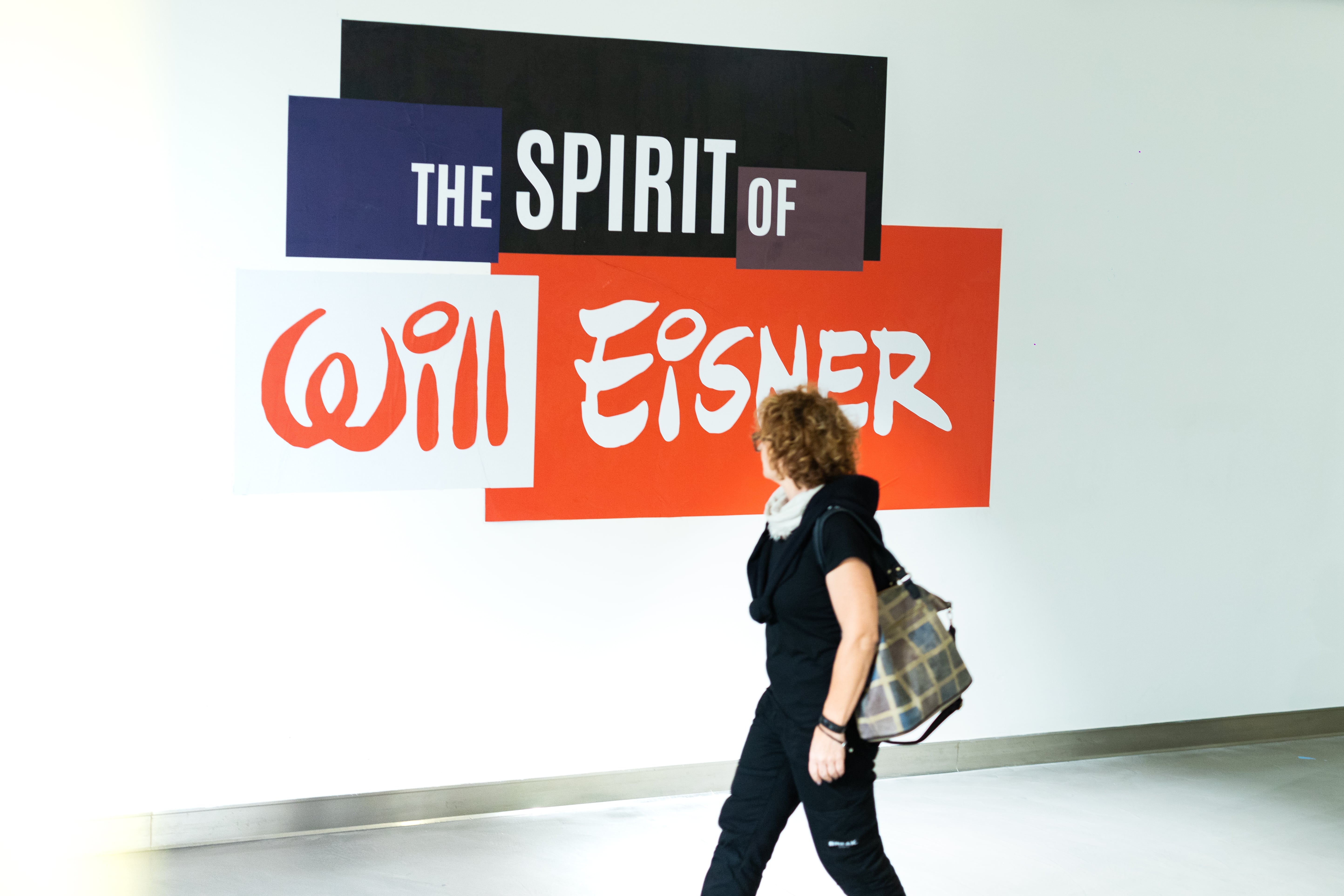Video of the exhibition “The Spirit of Will Eisner”.
Pordenone, 9th November 2022 — The gallery PAFF! (Palazzo Arti Fumetto Friuli) has opened its doors for the new William Eisner exhibition The Spirit of Will Eisner, running from 7 October until 26 February at Palazzo Galvani (Viale Dante 33) in collaboration with Paris-based 9ème Art Références.
There is no stopping PAFF! with its track record of attracting top dogs from the world of comics. It has swiftly made an international name for itself thanks to its high-quality exhibitions and prestigious featured artists. Following Cavazzano for Disney, Milton Caniff with his legendary American adventure strips, the Marvel and DC masters with their superheroes, a comprehensive look at Milo Manara beyond erotica, the most renowned fantasy and sci-fi comic book artist in the form of Moebius, and master Juanjo Guarnido, now it is the turn of Will Eisner.

American cartoonist and entrepreneur William Erwin Eisner is one of the greatest artists in comic book history. A passionate student of language – which he dubbed ‘sequential art’ – he developed an expressionistic technique early on, which aimed to maximise the emotional power of graphic storytelling through framing and shadow play.
Eisner’s work was universal but also relatable, embracing every aspect without leaving anything to chance. By using drawing, scriptwriting, composition, anatomy and the body language of his characters, Eisner managed to portray real life, how things were in the poor neighbourhoods where he himself had grown up. His work still influences many contemporary authors today. What makes the atmosphere in his stories is the inspiration he took from Pulp literature, thriller films and the New York city of the day. Another fundamental aspect to his art was the use of light and how the background was depicted. Light is often scarce in his works and the setting defined by just one or two elements, sufficient enough to give the scene its context. This means the reader can focus on the characters, dialogue and action. Water was another key element: raindrops, downpours, puddles… Water is a symbol of distress and discomfort, and weighs down the scenes.

The new Eisner exhibition will run for months until 26 February at PAFF! – Palazzo Arti Fumetto Friuli – based in Pordenone’s majestic Villa Galvani.
Giulio De Vita, the Artistic Director at PAFF! (Palazzo Arti Fumetto Friuli) and curator of the exhibition commented: “There are few people who have undoubtedly made the history of comics, those whose work and artform have contributed to transforming a popular subculture into an important, influential medium in today’s modern image-based society, but Will Eisner is one of them”. He added: “PAFF! has worked tirelessly to bring this important cartoonist to Pordenone, with an extensive exhibition that positions us at the crossroads between research, popularisation and entertainment”.
Tiziana Gibelli, Friuli Venezia Giulia’s Regional Councillor for Culture, remarked that: “Once again PAFF! has proved itself to be a leading light in the world of comic books, not just in Italy but across Europe. With this exhibition, The Spirit of William Eisner, Pordenone welcomes another big name in global comics. Eisner’s works represent a key milestone in the history of this artform, both for their innovative style and the type of stories they tell. This exhibition is sure to be a great cultural event, as well as an attraction for experts and enthusiasts from Italy and abroad’.”
Alberto Parigi, Pordenone City Council’s Councillor for Culture, stated: “The combined cultural offering provided by PAFF! and the City Council make Pordenone a real point of reference in the art scene, with a first-class programme lined up for the autumn and winter. Two big names – Eisner in comics and Erwitt in photography – will be on display, alongside other important exhibitions. This should serve to encourage us to network further and promote these initiatives together as a team, communicating and exploiting the city’s enormous potential and cultural pull, to the benefit of all involved.”

The exhibition will retrace Eisner’s footsteps including some 180 original works, from final strips to sketches, plus an additional 126 publications from his lifetime. The works will be displayed in different rooms according to theme, telling the story of comics and its evolution through images.
The graphic novel format became famous thanks to Eisner, when he wrote A Contract with God. The novelist saw its potential and transformed it into a children’s favourite, taking the comic strip concept from magazine to book format. In doing so, Eisner could do away with editorial obligations, and constraints regarding length and periodical publication dates. The atmosphere he created in his graphic novels is particularly intriguing, set in a dark, macabre New York, his hometown, in the Great Depression. These stories have flashes of autobiography and are extremely contemporary, almost futuristic. Eisner’s graphic novels succeeded in breaking the rigid rules of comics (despite him having chosen some of these rules himself), moving away from the comics industry and creating a different vision for the world of comics.

The prestigious exhibition location offers ample and impressive exhibition spaces: a historic villa, sleek modern art gallery, auditorium, learning area, large terrace, bookshop, cloakroom, offices, basement and coffee point.
